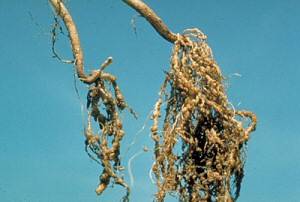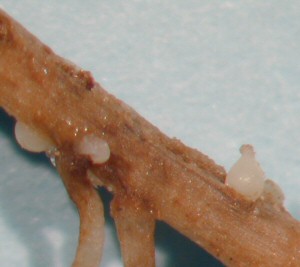Root-Knot (R-K) and Soybean Cyst Nematode (SCN)
 Hosts
Hosts
Soybeans.
Symptoms
Above ground symptoms of nematodes, either R-K or SCN, are not specific. Sometimes nematode-infested plants are often clumped within a row, which causes an uneven or wavy appearance to the rows. However, the amount of yellowing and stunting can vary dramatically between and within infected fields. Sometimes, there are no visual symptoms at all, or symptoms of other plant stresses such as drought or nutrient deficiency may be very pronounced. The presence of R-K or SCN can frequently be diagnosed in the field. Root-knot nematode causes the roots to produce characteristic swellings or galls which are easily distinguishable from nitrogen-fixing nodules. Female soybean cyst nematode can often be observed in the field as white to yellow cysts attached to the roots. Although visible to the naked eye, the female cysts are very small and can easily be missed. The most reliable method of detection is to submit a soil and root sample to the OSU Plant Disease and Insect Diagnostic Laboratory.
Control
 Control of both nematodes is most effectively obtained through a "nematode management
program." The goal of the management program is to reduce nematode populations below
damaging levels and to prevent the development of races or strains of SCN capable
of damaging resistant varieties. The use of crop rotations combined with the use of
soybean varieties resistant to SCN and/or R-K generally provides control of these
pests. It must be emphasized that the effectiveness of resistant varieties decreases
over time if they are continually grown in nematode infested fields. (Contact your
local OSU County Extension Agriculture Agent for a current list of soybean varieties
resistant to SCN and R-K). Growers who have fields with a history of nematode problems
need to develop a management strategy that includes crop rotation of nematode resistant
and susceptible varieties. A minimum four year rotation is recommended.
Control of both nematodes is most effectively obtained through a "nematode management
program." The goal of the management program is to reduce nematode populations below
damaging levels and to prevent the development of races or strains of SCN capable
of damaging resistant varieties. The use of crop rotations combined with the use of
soybean varieties resistant to SCN and/or R-K generally provides control of these
pests. It must be emphasized that the effectiveness of resistant varieties decreases
over time if they are continually grown in nematode infested fields. (Contact your
local OSU County Extension Agriculture Agent for a current list of soybean varieties
resistant to SCN and R-K). Growers who have fields with a history of nematode problems
need to develop a management strategy that includes crop rotation of nematode resistant
and susceptible varieties. A minimum four year rotation is recommended.
Year 1: Nonhost crop
Year 2: SCN resistant variety
Year 3: Nonhost crop
Year 4: SCN susceptive variety
Nonhost crops for SCN: alfalfa, canola, corn, cotton, forage grasses, rye, wheat, melons, oats, peanuts, red clover, rice, sorghum. Nonhost crops for Root-Knot: wheat, oats, corn, rye.
For fields infested with R-K nematode, a similar rotation should be followed with R-K resistant or susceptible varieties inserted in the rotation in place of the SCN varieties. Nematicides (chemicals that kill nematodes) have also been used to manage nematode populations. However, because of the narrow profit margin for soybeans, the cost of application is often prohibitive. Therefore, control centers around non-chemical methods such as crop rotation, resistant varieties, deep tillage, and fallow plowing, which will reduce the severity and incidence of nematode infestations. Please contact your local county extension office for current information.
